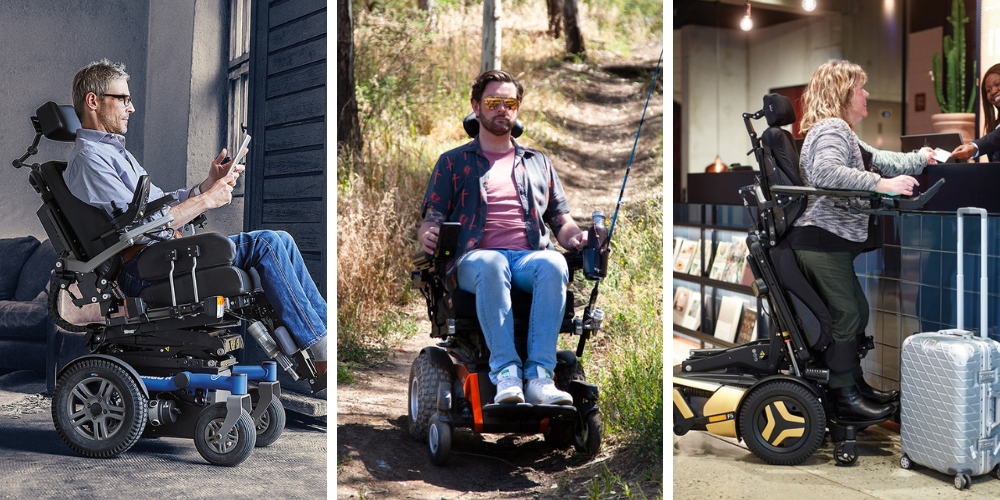TIPS FOR SELECTING A POWERED WHEELCHAIR

When it comes to powerchairs, there are many options to choose from - different types, different sizes, different technologies, different performance characteristics...the list goes on.
But how do you go about narrowing down the choice for yourself or for your client? Here are our tips on how to select the most suitable model...
1. How will the powerchair be used?
Will it be used most of the day, every day, or will it just have occasional use?
For someone spending extended periods of time in a wheelchair, a model which offers high levels of comfort and postural support will be required. If it’s for occasional use, however, a lighter model may be suitable.
Will the wheelchair need to be regularly transported in a car?
Lighter weight and folding models are ideal for people who regularly travel by car. They are designed to be dismantled and re-assembled quickly and easily, so they easily fit into a standard sized boot.
2. Where will the powered wheelchair be used?
Will the chair mainly be used indoors, outdoors, or a combination of both? Does the chair need to cope with rougher terrains?
Models of powered wheelchair designed specifically for indoor use tend to be more compact and have small turning circles, so they can tackle tight turns and are easy to manoeuvre.
Indoor-outdoor powerchairs are designed predominantly for indoor use, so are generally more compact, but can also be used outdoors.
Outdoor-indoor powered wheelchairs, on the other hand, are designed primarily for outdoor use, so will be wider and more robust, but they can also be used indoors.
For more adventurous outdoor use, an increasing range of all-terrain powered wheelchairs, such as the Magic Mobility Magic 360 are becoming available that open up a world of possibilities.
3. What type of drive system might be best?
There are 3 types of drive system – front-wheel, mid-wheel, and rear-wheel drive.
Front-wheel drive (FWD) systems have the drive wheels positioned at the front of the powerchair. This enables the wheelchair to tackle large bumps easily and can climb kerbs smoothly. FWD powered wheelchairs tend to be stable and, despite not having the smallest turning circle, can easily manoeuvre around tight corners.
Mid-wheel drive (MWD) chassis have their drive wheels at the centre of the chair. They have the tightest turning radius, so are best for indoor use, and are also very stable.
Rear-wheel drive (RWD) systems have the drive wheels located at the back of the wheelchair. This ensures greatest stability when travelling over rough terrain, but they have a wider base so are not best suited for indoor use.
4. What type of seating is required?
Comfort and posture management are critical for people spending a lot of time in a powered wheelchair. There are many different types of backrests and wheelchair cushions on the market to accommodate basic or more complex needs, so it’s important to select the correct ones.
Many powerchairs also offer powered seating options such as tilt-in-space, backrest recline, elevating leg rests, and seat lift, which enable even greater levels of posture management, as well as functional and social benefits.
5. How fast does the chair need to go?
The maximum speed will likely be determined by who is using the powered wheelchair, but it can often be adjusted over time. Most powerchairs have top speeds of 4, 6 or 8mph, so it’s possible to go with a higher top speed chair but edit the settings to limit the maximum speed. This is particularly useful for children or for someone using a powerchair for the first time – the top speed can be limited until they become confident at using their chair.
6. Does the powered wheelchair need to cover a specific distance on one charge?
Range is determined by battery size, and although manufacturers do advertise ranges, they should be used as a guide only, as they can be affected by many different factors. However, range estimates are useful in helping to determine what battery size is needed to accommodate the required daily usage before needing to charge.
7. What type of controller would be most suitable?
Most powered wheelchairs come with a joystick and keypad controller system, which can be located on either armrest. Basic and advanced models are available - advanced systems offering a wider range of functionality, including control of Blue Tooth and infra-red devices.
For those who need assistance with manoeuvring their wheelchair, attendant controls may be the ideal solution. These are usually located at the back of the chair for the carer to use when walking behind.
Alternatively, revolutionary new head/foot steering systems are becoming available, such as the CoMoveIT Smart, which allow those with complex movement disorders to control their powerchairs themselves. With a light touch of suitably mounted pressure-sensitive pads, the user can independently travel where they choose.